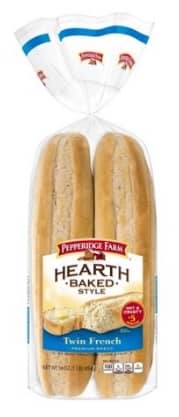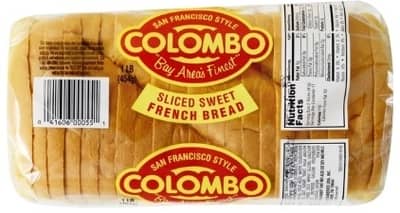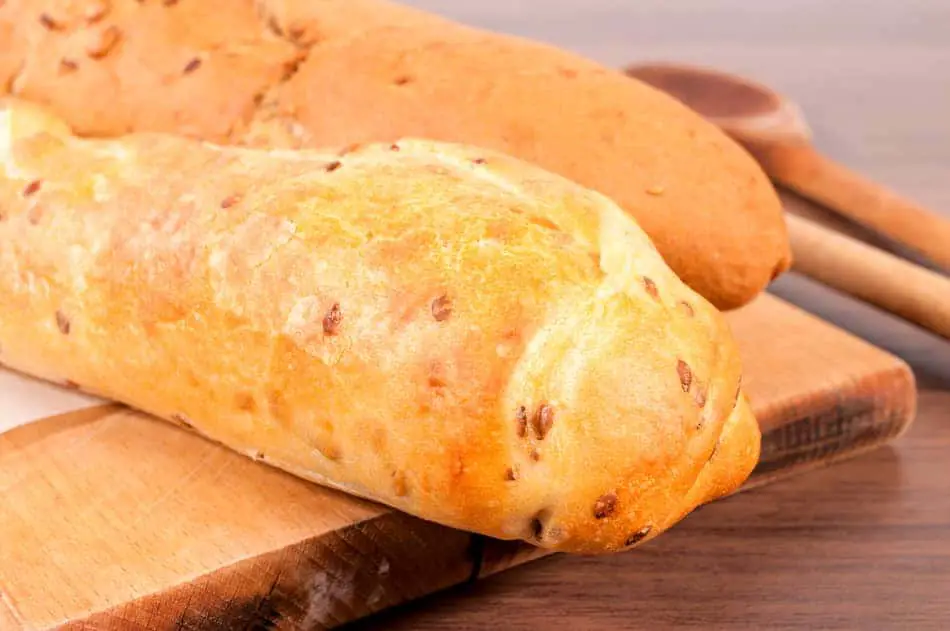French bread is a crusty white bread typically baked in long thin loaves.1 Baguettes are a variation of French bread (probably the most popular) and are likely what you think of when you hear the term French bread.
Is it vegan? Yes, traditional French bread is considered vegan. The standard recipe calls for wheat flour, yeast, water, and common salt. It can contain broad bean flour (~2%), wheat malt flour (~0.3%), soya flour (up to 0.5%).2 It can also contain milk but tends not to.
A Quick Distinction
Here in the US, the term “French bread” usually refers to loaves of bread with a characteristically long and thin shape—i.e. the baguette.
Outside the US, “French bread” can refer to a number of different breads, including, but not limited to the standard baguette.3
Other types of French bread include:3
- Ficelle—a small, thin version of the baguette
- Pain de campagne—a rounded loaf with sourdough
- Regional French bread—those containing figs, walnuts, or milk
For this article, I’ll mostly cover baguettes and will largely be using French bread and baguettes interchangeably.
Why French Bread Is Considered Vegan
It Achieves Its Unique Properties Without Animal Products
French bread has a lot of unique characteristics so folks often want to know if it’s vegan. After all, any time you notice unique properties in a food product, you have to wonder whether or not animal products were needed to achieve its characteristics.
Yeast fermentation is one aspect of French bread that contributes to its unique character.
Fermenting yeasts provides various yeast breads with their unique flavor and aroma through the formation of volatile and nonvolatile compounds:
- Nonvolatile compounds. These are the products produced by yeast that are too large to become airborne and include certain saccharides (carbs) and amino acids (AAs). Since they’re not airborne, they contribute to flavor more so than to aroma.* Specifically, they generate flavor signatures via the Maillard reaction—chemical reactions that take place between reducing sugars and AAs that browns baked goods and gives them a distinctive flavor flavor.
- Volatile compounds. These are substances that contribute to the odor of fermenting dough and include amylalcohol, isobutanol, isoamyl alcohol, esters, phenylethylalcohol, organic acids, and lactones.4 These are not too large to be airborne. A lot of alcohols like ethanol, isobutyl alcohol, n-propanol, etc. are formed during fermentation and leave the dough providing a nice aroma.5 For example, 2,5-dimethyl- 4-hydroxy-3(2H)-furanone results from the thermal reaction of certain AAs with sugars like fructose, glucose, and rhamnose providing a distinct odor.
*Also, carbonyl compounds and organic acids contribute to crust flavor. French bread is thought to get its unique flavor from its high level of acetic acid.6
Anyway, all this to say that French bread gets its qualities from non-animal derived organic compounds.
French bread gets its unique shape, in part, from the baking pans used. There are a number of pans used for yeast breads. They’re usually made in loaf pans (metal or glass), but French bread (specifically, baguettes) are made with specialized pans that are long and slender.7
One last characteristic is that French bread is known for staling quickly.8
This is thought to happen because French bread isn’t made with oil, thus it loses moisture more rapidly compared to other breads made with fat. This further adds to its vegan credentials, as high-fat bread often contains lard.
Milk Bread: The Non-Vegan French Bread
French milk bread or “Petit Pains au Lait” is a regional variation of the traditional milk bread recipe.
This type of bread is usually made with the following ingredients:9
- Warm Milk
- Yeast
- Sugar
- All-Purpose Flour
- Wheat Vital Gluten
- Salt
- Butter
- Milk
Also, keep in mind that some standard baguette recipes can contain milk. For example, the recipe outlined in the Joy of Cooking (a chef’s classic) calls for a ½ cup of scalded milk.10
Commercial Vegan French Bread
Most French bread is vegan, so this section isn’t really necessary. But, it will hopefully give you an idea of what typical store-bought French bread contains.
Freshness Guaranteed French Bread

Ingredients include:11
- Enriched Flour (Wheat Flour, Malted Barley Flour, Niacin, Ferrous sulfate, Thiamin Mononitrate, Riboflavin, Folic Acid)
- Water
- Yeast
- Salt
- Sugar
- Soybean Oil
- Datem
- Calcium Sulfate
- Ascorbic Acid
- Ammonium Sulfate
- Enzymes
- Vital Wheat Gluten
Pepperidge Farm Hearth Baked Style Twin French Bread

Ingredients include:12
- Enriched Wheat Flour (Flour, Niacin, Reduced Iron, Thiamine Mononitrate, Riboflavin, Folic Acid)
- Water
- Yeast
- Soybean Oil
- Salt
- Sugar
- Yellow Corn Meal
- Calcium Propionate
- Sorbic Acid
- Monoglycerides
- Malted Barley Flour.
Marketside French Baguette

Ingredients include:13
- Enriched wheat flour (wheat flour, niacin, reduced iron, thiamine mononitrate, riboflavin, folic acid, enzymes)
- Water
- Salt
- Yeast
- Gluten
- Diacetyl tartaric ester acid of mono- and diglycerides
- Distilled monoglycerides
- Dextrose
- Dough conditioner (ascorbic acid, enzymes)
Francisco International French Sliced Bread

Ingredients include:14
- Wheat Flour
- Malted Barley Flour
- Niacin
- Reduced Iron
- Thiamine Mononitrate
- Riboflavin
- Folic Acid
- Water
- Wheat Gluten
- Yeast
- Salt
- Sugar
- Palm Oil
- Calcium Propionate (Preservative)
- Calcium Sulfate
- Dextrose
- Diacetyl Tartaric Esters of Mono/Diglycerides (Datem)
A Note on Mono/Diglycerides
You may have noticed these ingredients in some of the breads above. They’re very common in baked goods and are usually used as emulsifiers.15,16
They’re kind of a grey area because they’re often derived from animals.17,18
So, some vegans want to avoid them.
Sometimes the label will state “plant-based”, etc. but it’s pretty rare, especially for food products that are “accidentally vegan.”
Keep in mind, the presence of these compounds doesn’t make a food product non-vegan by most standards, because there’s a good chance they’re from plant sources. But, if you wanna be extra careful, this is something to keep in mind. It should be fairly easy to find bread products without them.
A Note on Enzymes
Certain (specific) enzymes are listed in PETA’s animal-derived ingredients list, but the ambiguous ingredient “enzymes” are not listed.19
Enzymes are used in dough for a few reasons:20
- Flour supplementation
- Dough conditioning
- The synergistic effects of enzymes
- Reduction of acrylamide content in food products
A lot of enzymes common to bread are completely vegan-friendly but others aren’t. Because they’re often just listed as “enzymes” some vegans want to avoid the ingredients altogether.
But, most vegans don’t scrutinize such ingredients too heavily, because there’s a good chance they are vegan, and there’s no way of knowing short of asking the manufacturers directly.
Like with glycerides, some products will specify when the enzymes are of plant origin. So, if you want to make sure and avoid non-vegan enzymes, you can find bread without the ingredient or just stick to products with labels that read “enzymes (plant-based)” or what have you.
That pretty much wraps it up for French bread and baguettes. Thanks for reading.
You may also want to check out other related articles:
- Is Rye Bread Really Vegan?
- Is Pita Bread Vegan? What About Pita Chips?
- Are Bagels Really Vegan? The Bottom Line
- Are English Muffins Vegan?
- Is Apple Pie Vegan? (List of Vegan Options)
- Is Angel Food Cake Vegan?
- Are Cinnamon Rolls Vegan?
- Are Croissants Vegan?
References
- French Bread. https://www.merriam-webster.com/dictionary/French%20bread
- “Détail d’un texte” (in French). Legifrance.gouv.fr. http://www.legifrance.gouv.fr/WAspad/UnTexteDeJorf?numjo=ECOC9300130D
- Difference Between French Bread and Italian Bread. Reluctant gourmet – https://www.reluctantgourmet.com/difference-french-italian-bread/
- Labuda I, C Stegmann, and R Huang. Yeasts and their role in fl avor formation. Cereal Foods World 42(10):797–799, 1997.
- deMan JM. Principles of Food Chemistry. Van Nostrand Reinhold, 1999
- Understanding Food: Principles and Preparation (Page 426). Amy Brown – Wadsworth Cengage Learning – 2011
- Understanding Food: Principles and Preparation (Page 424). Amy Brown – Wadsworth Cengage Learning – 2011
- Understanding Food: Principles and Preparation (Page 431). Amy Brown – Wadsworth Cengage Learning – 2011
- Petit Pains au Lait (French Milk Bread). https://cookpad.com/us/recipes/2614909-petit-pains-au-lait-french-milk-bread
- Joy Of Cooking (Page 605). Irma Rombauer-Marion Becker-Ginnie Hofmann-Ikki Matsumoto – Plume Book – 1997
- Freshness Guaranteed French Bread, 14 oz. https://www.walmart.com/ip/Freshness-Guaranteed-French-Bread-14-oz/46491756
- Pepperidge Farm Hearth Baked Style Twin French Bread, 16 oz. Bag. https://www.walmart.com/ip/Pepperidge-Farm-Hearth-Baked-Style-Twin-French-Bread-16-oz-Bag/10535431
- Marketside French Baguette. https://www.walmart.com/ip/Marketside-French-Baguette-8-3-oz/55234444
- Francisco International French Sliced Bread. https://www.instacart.com/safeway/products/2646146-colombo-sliced-sweet-french-bread-16-oz
- Monoglyceride. https://en.wikipedia.org/wiki/Monoglyceride#Uses
- Diglyceride. https://en.wikipedia.org/wiki/Diglyceride
- Monoglyceride Synthesis. https://en.wikipedia.org/wiki/Monoglyceride#Synthesis
- Sonntag, Norman O. V. (1982). “Glycerolysis of fats and methyl esters — Status, review and critique”. Journal of the American Oil Chemists’ Society. 59 (10): 795A–802A.
- Animal-derived Ingredients Resource | Living. https://www.peta.org/living/food/animal-ingredients-list/
- Enzyme Applications in Baking http://www.biokemi.org/biozoom/issues/516/articles/2309

